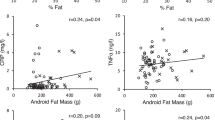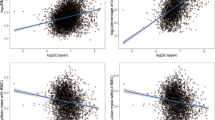Abstract
This study aimed to explore the association of the plasma copper concentration with body fat distribution and the potential mediating effect of inflammation status in children. A total of 454 children were recruited in this study. Dual-energy X-ray absorptiometry was applied to measure the fat mass (FM) and fat mass percentages (FM%) at whole body, trunk, appendicular, android, and gynoid regions. Android to gynoid fat mass ratio and fat mass to lean mass (FM/LM) ratio at whole body, trunk, and appendicular sites were calculated. Plasma copper concentration was measured via inductively coupled plasma mass spectrometry. C-reactive protein (CRP) was determined by ELISA. After adjusting for covariates, multiple linear regression analyses showed that, for every additional unit increase in the plasma copper concentration, the FM, FM%, and FM/LM at whole body and subregions increased by 0.030–0.472 kg (P < 0.001–0.019), 0.013–1.04% (P = 0.007–0.042), and 0.021–0.030 (P < 0.001), respectively. Mediating analysis suggested that CRP significantly mediated 22.0–30.6% (P < 0.001) of the estimated association of copper with FM% and FM/LM at whole body and limbs. Thus, children with higher plasma levels of copper tended to have a higher regional and overall body fat deposition, and this relationship was partly mediated by inflammatory status.


Similar content being viewed by others
References
Chooi YC, Ding C, Magkos F (2019) The epidemiology of obesity. Metabolism 92:6–10. https://doi.org/10.1016/j.metabol.2018.09.005
Fernandez-Sanchez A, Madrigal-Santillan E, Bautista M, Esquivel-Soto J, Morales-Gonzalez A, Esquivel-Chirino C, Durante-Montiel I, Sanchez-Rivera G, Valadez-Vega C, Morales-Gonzalez JA (2011) Inflammation, oxidative stress, and obesity. Int J Mol Sci 12(12):3117–3132. https://doi.org/10.3390/ijms12053117
Marseglia L, Manti S, D’Angelo G, Nicotera A, Parisi E, Di Rosa G, Gitto E, Arrigo T (2014) Oxidative stress in obesity: a critical component in human diseases. Int J Mol Sci 16(1):378–400. https://doi.org/10.3390/ijms16010378
Codoner-Franch P, Boix-Garcia L, Simo-Jorda R, del Castillo-Villaescusa C, Maset-Maldonado J, Valls-Belles V (2010) Is obesity associated with oxidative stress in children? Int J Pediatr Obes 5(1):56–63. https://doi.org/10.3109/17477160903055945
Gaetke LM, Chow-Johnson HS, Chow CK (2014) Copper: toxicological relevance and mechanisms. Arch Toxicol 88(11):1929–1938. https://doi.org/10.1007/s00204-014-1355-y
Yasui K, Baba A (2006) Therapeutic potential of superoxide dismutase (SOD) for resolution of inflammation. Inflamm Res 55(9):359–363. https://doi.org/10.1007/s00011-006-5195-y
Younus H (2018) Therapeutic potentials of superoxide dismutase. Int J Health Sci (Qassim) 12(3):88–93
Gaetke LM, Chow CK (2003) Copper toxicity, oxidative stress, and antioxidant nutrients. Toxicology 189(1–2):147–163. https://doi.org/10.1016/s0300-483x(03)00159-8
Harvey LJ, Ashton K, Hooper L, Casgrain A, Fairweather-Tait SJ (2009) Methods of assessment of copper status in humans: a systematic review. Am J Clin Nutr 89(6):2009S–2024S. https://doi.org/10.3945/ajcn.2009.27230E
Azab SF, Saleh SH, Elsaeed WF, Elshafie MA, Sherief LM, Esh AM (2014) Serum trace elements in obese Egyptian children: a case-control study. Ital J Pediatr 40:20. https://doi.org/10.1186/1824-7288-40-20
Cayir Y, Cayir A, Turan MI, Kurt N, Kara M, Laloglu E, Ciftel M, Yildirim A (2014) Antioxidant status in blood of obese children: the relation between trace elements, paraoxonase, and arylesterase values. Biol Trace Elem Res 160(2):155–160. https://doi.org/10.1007/s12011-014-0038-0
Habib SA, Saad EA, Elsharkawy AA, Attia ZR (2015) Pro-inflammatory adipocytokines, oxidative stress, insulin, Zn and Cu: interrelations with obesity in Egyptian non-diabetic obese children and adolescents. Adv Med Sci 60(2):179–185. https://doi.org/10.1016/j.advms.2015.02.002
Lima SC, Arrais RF, Sales CH, Almeida MG, de Sena KCM, Oliveira VTL, de Andrade AS, Pedrosa LFC (2006) Assessment of copper and lipid profile in obese children and adolescents. Biol Trace Elem Res 114(1–3):19–29. https://doi.org/10.1385/BTER:114:1:19
Yerlikaya FH, Toker A, Aribas A (2013) Serum trace elements in obese women with or without diabetes. Indian J Med Res 137(2):339–345
Chen ZTX, Ying X, Pan L, Li C (2015) Results of serum minerals detection in obese children. Zhejiang Prev Med 27(12):1247–1250
Perrone L, Gialanella G, Moro R, Feng SL, Boccia E, Palombo G, Carbone MT, Di Toro R (1998) Zinc, copper, and iron in obese children and adolescents. Nutr Res 18(2):183–189. https://doi.org/10.1016/S0271-5317(98)00011-6
Gu YCW, Qi Z, Chen Y (2016) Investigating relationship between plasma zinc and copper level and elderly obesity. World Latest Med Inf 4:4–6
Ruiz JR, Ortega FB, Wärnberg J, Moreno LA, Carrero JJ, Gonzalez-Gross M, Marcos A, Gutierrez A, Sjöström M (2008) Inflammatory proteins and muscle strength in adolescents: the Avena study. Arch Pediatr Adolesc Med 162(5):462–468. https://doi.org/10.1001/archpedi.162.5.462
Tascilar ME, Ozgen IT, Abaci A, Serdar M, Aykut O (2011) Trace elements in obese Turkish children. Biol Trace Elem Res 143(1):188–195. https://doi.org/10.1007/s12011-010-8878-8
Gu K, Li X, Xiang W, Jiang X (2019) The relationship between serum copper and overweight/obesity: a meta-analysis. Biol Trace Elem Res 194:336–347. https://doi.org/10.1007/s12011-019-01803-6
Okosun IS, Seale JP, Lyn R (2015) Commingling effect of gynoid and android fat patterns on cardiometabolic dysregulation in normal weight American adults. Nutr Diabetes 5:e155. https://doi.org/10.1038/nutd.2015.5
Jensen NS, Camargo TF, Bergamaschi DP (2016) Comparison of methods to measure body fat in 7-to-10-year-old children: a systematic review. Public Health 133:3–13. https://doi.org/10.1016/j.puhe.2015.11.025
Margulies L, Horlick M, Thornton JC, Wang J, Ioannidou E, Heymsfield SB (2005) Reproducibility of pediatric whole body bone and body composition measures by dual-energy X-ray absorptiometry using the GE Lunar Prodigy. J Clin Densitom 8(3):298–304. https://doi.org/10.1385/JCD:8:3:298
Zanini Rde V, Santos IS, Chrestani MA, Gigante DP (2015) Body fat in children measured by DXA, air-displacement plethysmography, TBW and multicomponent models: a systematic review. Matern Child Health J 19(7):1567–1573. https://doi.org/10.1007/s10995-015-1666-5
Chen GD, Yan HC, Hao YT, Shrestha S, Wang J, Li Y, Wei YH, Pan JL, Zhang ZQ (2019) Comparison of various anthropometric indices in predicting abdominal obesity in Chinese children: a cross-sectional study. BMC Pediatr 19(1):127. https://doi.org/10.1186/s12887-019-1501-z
Liang JJ, Guo YF, Dai MX, Xiao QP, Cai WL, Wei YH, Amakye WK, Jing J, Zhang ZQ (2018) Differences in relationships of maternal and paternal age at childbirth with body fat distribution in offspring. Am J Hum Biol 30(6):e23143. https://doi.org/10.1002/ajhb.23143
Yang YWG, X P. (2009) China food composition table. Peking University Medical Press, Beijing
Amakye WK, Zhang Z, Wei Y, Shivappa N, Hebert JR, Wang J, Su Y, Mao L (2018) The relationship between dietary inflammatory index (DII) and muscle mass and strength in Chinese children aged 6-9 years. Asia Pac J Clin Nutr 27(6):1315–1324. https://doi.org/10.6133/apjcn.201811_27(6).0019
Ainsworth BE, Haskell WL, Herrmann SD, Meckes N, Bassett DR Jr, Tudor-Locke C, Greer JL, Vezina J, Whitt-Glover MC, Leon AS (2011) 2011 Compendium of Physical Activities: a second update of codes and MET values. Med Sci Sports Exerc 43(8):1575–1581. https://doi.org/10.1249/MSS.0b013e31821ece12
Tingley D, Yamamoto T, Hirose K, Keele L, Imai K (2014) Mediation: R package for causal mediation analysis. J Stat Softw 059. https://doi.org/10.18637/jss.v059.i05
Konz T, Santoro A, Goulet L, Bazzocchi A, Battista G, Nicoletti C, Kadi F, Ostan R, Goy M, Monnard C, Martin FP, Feige JN, Franceschi C, Rezzi S (2018) Sex-specific associations of blood-based nutrient profiling with body composition in the elderly. Front Physiol 9:1935. https://doi.org/10.3389/fphys.2018.01935
Yang H, Liu CN, Wolf RM, Ralle M, Dev S, Pierson H, Askin F, Steele KE, Magnuson TH, Schweitzer MA, Wong GW, Lutsenko S (2019) Obesity is associated with copper elevation in serum and tissues. Metallomics 11(8):1363–1371. https://doi.org/10.1039/c9mt00148d
Darroudi S, Fereydouni N, Tayefi M, Esmaily H, Sadabadi F, Khashyarmanesh Z, Tayefi B, Haghighi HM, Timar A, Mohammadpour AH, Gonoodi K, Ferns GA, Hoseini SJ, Ghayour-Mobarhan M (2019) Altered serum zinc and copper in Iranian adults who were of normal weight but metabolically obese. Sci Rep 9:14874. https://doi.org/10.1038/s41598-019-51365-9
Zhang J, Cao J, Zhang H, Jiang C, Lin T, Zhou Z, Song Y, Li Y, Liu C, Liu L, Wang B, Tang G, Li J, Zhang Y, Cui Y, Huo Y, Yang Y, Ling W, Yang J, Guo H, Wang X, Xu X, Qin X (2019) Plasma copper and the risk of first stroke in hypertensive patients: a nested case-control study. Am J Clin Nutr. https://doi.org/10.1093/ajcn/nqz099
Mangge H, Summers K, Almer G, Prassl R, Weghuber D, Schnedl W, Fuchs D (2013) Antioxidant food supplements and obesity-related inflammation. Curr Med Chem 20(18). https://doi.org/10.2174/0929867311320180004
Guzik TJ, Korbut R, Adamek-Guzik T (2004) Nitric oxide and superoxide in inflammation and immune regulation. J Physiol Pharmacol 54(4):469–487. https://doi.org/10.1152/jn.00313.2003
Kim OY, Shin MJ, Moon J, Chung JH (2011) Plasma ceruloplasmin as a biomarker for obesity: a proteomic approach. Clin Biochem 44(5–6):351–356. https://doi.org/10.1016/j.clinbiochem.2011.01.014
Schmalz G, Schuster U, Schweikl H (1998) Influence of metals on IL-6 release in vitro. Biomaterials 19(18):1689–1694. https://doi.org/10.1016/s0142-9612(98)00075-1
Bar-Or D, Thomas GW, Yukl RL, Rael LT, Shimonkevitz RP, Curtis CG, Winkler JV (2003) Copper stimulates the synthesis and release of interleukin-8 in human endothelial cells: a possible early role in systemic inflammatory responses. Shock 20(2):154–158. https://doi.org/10.1097/01.shk.0000068318.49350.3a
Suska F, Esposito M, Gretzer C, Kalltorp M, Tengvall P, Thomsen P (2003) IL-1alpha, IL-1beta and TNF-alpha secretion during in vivo/ex vivo cellular interactions with titanium and copper. Biomaterials 24(3):461–468. https://doi.org/10.1016/s0142-9612(02)00359-9
Suska F, Gretzer C, Esposito M, Emanuelsson L, Wennerberg A, Tengvall P, Thomsen P (2005) In vivo cytokine secretion and NF-kappaB activation around titanium and copper implants. Biomaterials 26(5):519–527. https://doi.org/10.1016/j.biomaterials.2004.02.066
Kennedy T, Ghio AJ, Reed W, Samet J, Zagorski J, Quay J, Carter J, Dailey L, Hoidal JR, Devlin RB (1998) Copper-dependent inflammation and nuclear factor-kappaB activation by particulate air pollution. Am J Respir Cell Mol Biol 19(3):366–378. https://doi.org/10.1165/ajrcmb.19.3.3042
Wellen KE, Hotamisligil GS (2003) Obesity-induced inflammatory changes in adipose tissue. J Clin Invest 112(12):1785–1788. https://doi.org/10.1172/JCI20514
Tam CS, Clement K, Baur LA, Tordjman J (2010) Obesity and low-grade inflammation: a paediatric perspective. Obes Rev 11(2):118–126. https://doi.org/10.1111/j.1467-789X.2009.00674.x
Ellulu MS, Patimah I, Khaza’ai H, Rahmat A, Abed Y (2017) Obesity and inflammation: the linking mechanism and the complications. Arch Med Sci 13(4):851–863. https://doi.org/10.5114/aoms.2016.58928
Funding
This work received support from the National Natural Science Foundation of China (No. 81903347 and No. 81973045), and the Fund from Guangzhou Institute of Pediatrics/Guangzhou Women and Children’s Medical Center (No. YIP-2019-043).
Author information
Authors and Affiliations
Corresponding author
Ethics declarations
All procedures used in this study were approved by the ethics committee of the School of Public Health at Sun Yat-sen University.
Conflict of Interest
The authors declare that they have no conflict of interest.
Additional information
Publisher’s Note
Springer Nature remains neutral with regard to jurisdictional claims in published maps and institutional affiliations.
Rights and permissions
About this article
Cite this article
Liang, J., Chen, F., Fang, G. et al. Relationship Between Plasma Copper Concentration and Body Fat Distribution in Children in China: a Cross-Sectional Study. Biol Trace Elem Res 198, 430–439 (2020). https://doi.org/10.1007/s12011-020-02105-y
Received:
Accepted:
Published:
Issue Date:
DOI: https://doi.org/10.1007/s12011-020-02105-y




